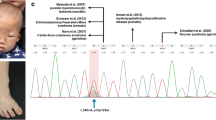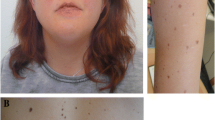Abstract
Noonan syndrome (NS) is a genetic condition presenting with typical facies, cardiac defects, short stature, variable developmental deficit, cryptorchidism, skeletal, and other abnormalities. Germline mutations in genes involved in the RAS/MAPK signaling have been discovered to underlie NS. Recently, missense mutations in RIT1 have been reported as causative for individuals with clinical signs of NS. We report on a 2.5-year-old boy with NS phenotype with a novel heterozygous change in the RIT1 gene. The patient was born prematurely from pregnancy monitored for polyhydramnios. At 7 months of age, non-immune neutropenia and splenomegaly have been observed. During the severe pneumonia at 10 months, significant progression of hepatosplenomegaly, leukopenia with monocytosis (15–29 %), and thrombocytopenia occurred. Bone marrow evaluation showed myeloid hyperplasia and monocytosis, suggestive of myeloproliferative syndrome. Clinical phenotype (facial dysmorphism, soft hair, short neck, broad chest, widely spaced nipples, mild pectus carinatum, deep palmar creases, unilateral cryptorchidism), and moderate pulmonary valve stenosis with mild psychomotor delay were indicative of NS. DNA analysis identified a de novo heterozygous variant c.69A >T, p.(Lys23Asn) in exon 2 of the RIT1 gene, presumed to be causative.
Conclusion: We present a patient with a clinical suspicion of NS carrying a novel substitution in RIT1 and hematologic findings not being observed in RIT1 positive patients to date. Thus, the case broadens variability of hematologic symptoms in RIT1 positive NS individuals.
What is known: • Noonan syndrome is a common genetically heterogeneous disorder of autosomal dominant inheritance characterized by craniofacial dysmorphism, short stature, congenital heart defects, variable cognitive deficit, and other anomalies. |
What is new: • We report on a 2.5-year-old male patient with clinical signs of NS and hematologic abnormalities, in whom a novel heterozygous substitution in RIT1 with probable pathogenicity was detected. |

Similar content being viewed by others
Abbreviations
- BRAF:
-
V-raf murine sarcoma viral oncogene homolog B
- CBL:
-
Cbl proto-oncogene
- CMV:
-
Cytomegalovirus
- COSMIC:
-
Catalog of somatic mutations in cancer
- dbSNP:
-
Database of single nucleotide polymorphisms
- DNA:
-
Deoxyribonucleic acid
- ELK1:
-
Member of ETS oncogene family
- EBV:
-
Epstein-Barr virus
- GTP:
-
Guanosine-5′-triphosphate
- HCM:
-
Hypertrophic cardiomyopathy
- HGMD:
-
Human Gene Mutation Database
- HHV-6:
-
Human herpesvirus 6
- KRAS:
-
Kirsten rat sarcoma viral oncogene homolog
- LZTR1:
-
Leucine-zipper-like transcription regulator 1
- MAP2K1:
-
Mitogen-activated protein kinase kinase 1
- MAP2K2:
-
Mitogen-activated protein kinase kinase 2
- NHLBI:
-
National Heart, Lung, and Blood Institute
- NRAS:
-
Neuroblastoma RAS viral (v-ras) oncogene homolog
- NS:
-
Noonan syndrome
- OFC:
-
Occipitofrontal circumference
- PCR:
-
Polymerase chain reaction
- PTPN11:
-
Tyrosine-protein phosphatase non-receptor type 11
- RAF1:
-
V-raf-1 murine leukemia viral oncogene homolog 1
- RAS:
-
Rat sarcoma protein family
- RAS/MAPK:
-
RAS-mitogen-activated protein kinases
- RRAS:
-
Related RAS viral (R-RAS) oncogene homolog
- RSV:
-
Respiratory syncytial virus
- RIT1:
-
Ras-like without CAAX 1
- SHOC2:
-
Soc-2 suppressor of clear homolog
- SIFT:
-
Sorting Intolerant From Tolerant
- SOS1:
-
Son of sevenless homolog 1
- SOS2:
-
Son of sevenless homolog 2
Reference
Aoki Y, Niihori T, Banjo T, Okamoto N, Mizuno S, Kurosawa K, Ogata T, Takada F, Yano M, Ando T, Hoshika T, Barnett C, Ohashi H, Kawame H, Hasegawa T, Okutani T, Nagashima T, Hasegawa S, Funayama R, Nagashima T, Nakayama K, Inoue S, Watanabe Y, Ogura T, Matsubara Y (2013) Gain-of-function mutations in RIT1 cause Noonan syndrome, a RAS/MAPK pathway syndrome. Am J Hum Genet 93:173–180
Berger AH, Imielinski M, Duke F, Wala J, Kaplan N, Shi GX, Andres DA, Meyerson M (2014) Oncogenic RIT1 mutations in lung adenocarcinoma. Oncogene 33(35):4418–4423
Bertola DR, Yamamoto GL, Almeida TF, Buscarilli M, Jorge AAL, Malaquias AC, Kim CA, Takahashi VNV, Passos-Bueno MR, Pereira AC (2014) Further evidence of the importance of RIT1 in Noonan syndrome. Am J Med Genet A 9999:1–6
Chen PC, Yin J, Yu HW, Yuan T, Fernandez M, Yung CK, Trinh QM, Peltekova VD, Reid JG, Tworog-Dube E, Morgan MB, Muzny DM, Stein L, McPherson JD, Roberts AE, Gibbs RA, Neel BG, Kucherlapati R (2014) Next-generation sequencing identifies rare variants associated with Noonan syndrome. Proc Natl Acad Sci 111(31):11473–11478
Cordeddu V, Yin JC, Gunnarsson C, Virtanen C, Drunat S, Lepri F, De Luca A, Rossi C, Ciolfi A, Pugh TJ, Bruselles A, Priest JR, Pennacchio LA, Lu Z, Danesh A, Quevedo R, Hamid A, Martinelli S, Pantaleoni F, Gnazzo M, Daniele P, Lissewski C, Bocchinfuso G, Stella L, Odent S, Philip N, Faivre L, Vlckova M, Seemanova E, Digilio C, Zenker M, Zampino G, Verloes A, Dallapiccola B, Roberts AE, Cavé H, Gelb BD, Neel BG, Tartaglia M (2015) Activating mutations affecting the Dbl homology domain of SOS2 cause Noonan syndrome. Hum Mutat 36(11):1080–1087
Flex E, Jaiswal M, Pantaleoni F, Martinelli S, Strullu M, Fansa EK, Caye A, De Luca A, Lepri F, Dvorsky R, Pannone L, Paolacci S, Zhang S, Fodale V, Bocchinfuso G, Rossi C, Burkitt-Wright EMM, Farrotti A, Stellacci E, Cecchetti S, Ferese R, Bottero L, Castro S, Fenneteau O, Brethon B, Sanchez M, Roberts AE, Yntema HG, van der Burgt I, Cianci P, Bondeson ML, Digilio MC, Zampino G, Kerr B, Aoki Y, Loh ML, Palleschi A, Di Schiavi E, Carè A, Selicorni A, Dallapiccola B, Cirstea IC, Stella L, Zenker M, Gelb BD, Cavé H, Ahmadian MR, Tartaglia M (2014) Activating mutations in RRAS underlie a phenotype within the RASopathy spektrum and contribute to leukaemogenesis. Hum Mol Genet 23(16):4315–4327
Gómez-Seguí I, Makishima H, Jerez A, Yoshida K, Przychodzen B, Miyano S, Shiraishi Y, Husseinzadeh HD, Guinta K, Clemente M, Hosono N, McDevitt MA, Moliterno AR, Sekeres MA, Ogawa S, Maciejewski JP (2013) Novel recurrent mutations in the RAS-like GTP-binding gene RIT1 in myeloid malignancies. Leukemia 27:1943–1946
Gos M, Fahiminiya S, Poznański J, Klapecki J, Obersztyn E, Piotrowicz M, Wierzba J, Posmyk R, Bal J, Majewski J (2014) Contribution of RIT1 mutations to the pathogenesis of Noonan syndrome: four new cases and further evidence of heterogeneity. Am J Med Genet A 164A:2310–2316
Justino A, Dias P, João Pina M, Sousa S, Cirnes L, Sousa AB, Machado JC, Costa JL (2015) Comprehensive massive parallel DNA sequencing strategy for the genetic diagnosis of the neuro-cardio-facio-cutaneous syndromes. Eur J Hum Genet 23(3):347–353
Koenighofer M, Hung CY, McCauley JL, Dallman J, Back EJ, Mihalek I, Gripp KW, Sol-Church K, Rusconi P, Zhang Z, Shi GX, Andres DA, Bodamer OA (2015) Mutations in RIT1 cause Noonan syndrome – additional functional evidence and expanding the clinical phenotype. Clin Gen.
Kratz CP, Rapisuwon S, Reed H, Hasle H, Rosenberg PS (2011) Cancer in Noonan, Costello cardiofaciocutaneous and LEOPARD syndromes. Am J Med Genet C: Semin Med Genet 157:83–89
Shi GX, Cai W, Andres DA (2013) Rit subfamily small GTPases: regulators in neuronal differentiation and survival. Cell Signal 25:2060–2068
Tartaglia M, Niemeyer CM, Fragale A, Son X, Buechner J, Jung A, Hählen K, Hasle H, Licht JD, Gelb BD (2003) Somatic mutations in PTPN11 in juvenile myelomonocytic leukemia, myelodysplastic syndromes and acute myeloid leukemia. Nat Genet 34(2):148–150
Tartaglia M, Zampino G, Gelb BD (2010) Noonan syndrome: clinical aspects and molecular pathogenesis. Mol Syndromol 1:2–26
Yamamoto GL, Aguena M, Gos M, Hung C, Pilch J, Fahiminiya S, Abramowicz A, Cristian I, Buscarilli M, Naslavsky MS, Malaquias AC, Zatz M, Bodamer O, Majewski J, Jorge AA, Pereira AC, Kim CA, Passos-Bueno MR, Bertola DR (2015) Rare variants in SOS2 and LZTR1 are associated with Noonan syndrome. J Med Genet 52(6):413–421
Acknowledgments
We would like to thank the family members for participating in the study. This work was supported by grant for conceptual development of research organization University Hospital Motol 00064203 from the Ministry of Health of the Czech Republic.
Author’s contributions
MN wrote the article, critically reviewed the article, and contributed to data collection. SV, FF, and MS contributed to data collection and reviewed the article. AK was helpful in writing the article and critically reviewed the article.
Author information
Authors and Affiliations
Corresponding author
Ethics declarations
Funding
This study was funded by grant for conceptual development of research organization University Hospital Motol 00064203 from the Ministry of Health of the Czech Republic.
Conflict of Interest
The authors declare that they have no conflict of interest.
Ethical approval
This article does not contain any studies with human participants or animals performed by any of the authors.
Informed consent
Informed consent was obtained from all individual participants included in the study.
Additional information
Communicated by Beat Steinmann
Rights and permissions
About this article
Cite this article
Nemcikova, M., Vejvalkova, S., Fencl, F. et al. A novel heterozygous RIT1 mutation in a patient with Noonan syndrome, leukopenia, and transient myeloproliferation—a review of the literature. Eur J Pediatr 175, 587–592 (2016). https://doi.org/10.1007/s00431-015-2658-6
Received:
Revised:
Accepted:
Published:
Issue Date:
DOI: https://doi.org/10.1007/s00431-015-2658-6




